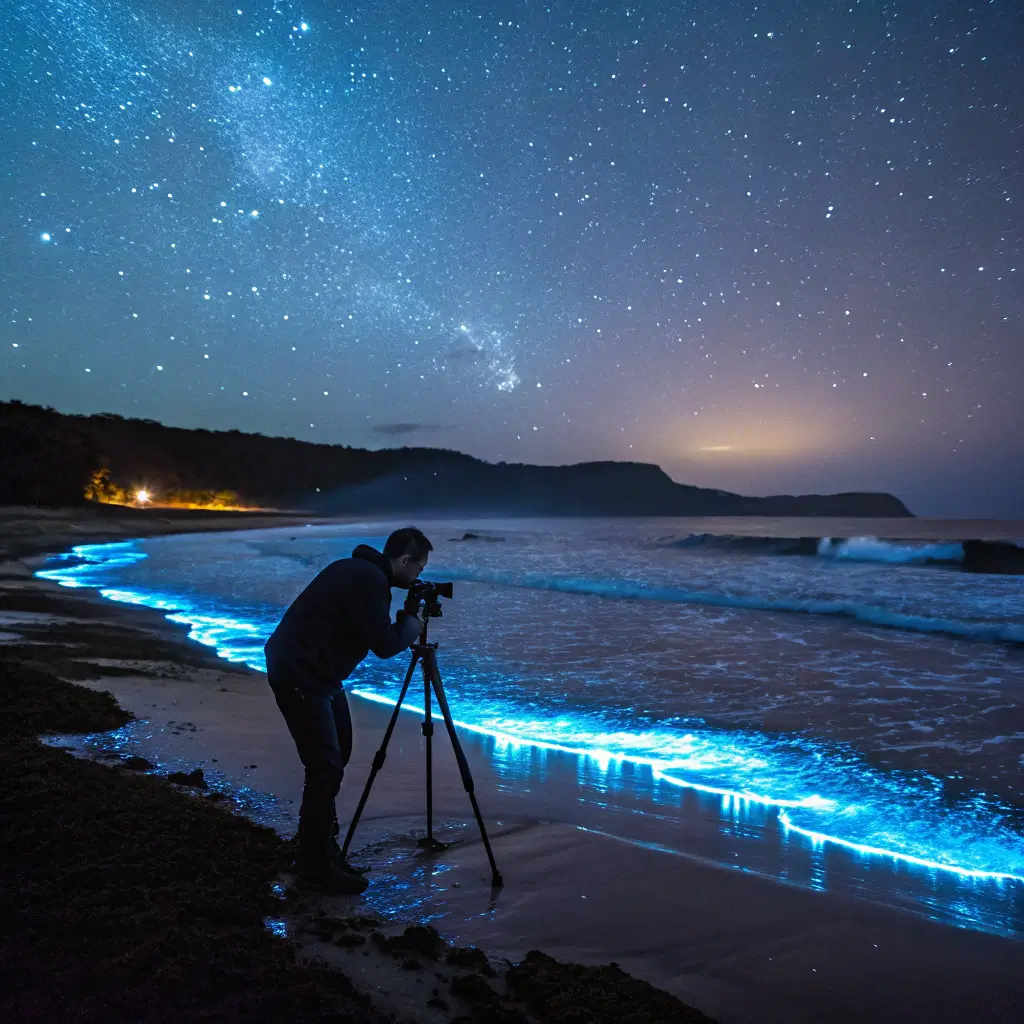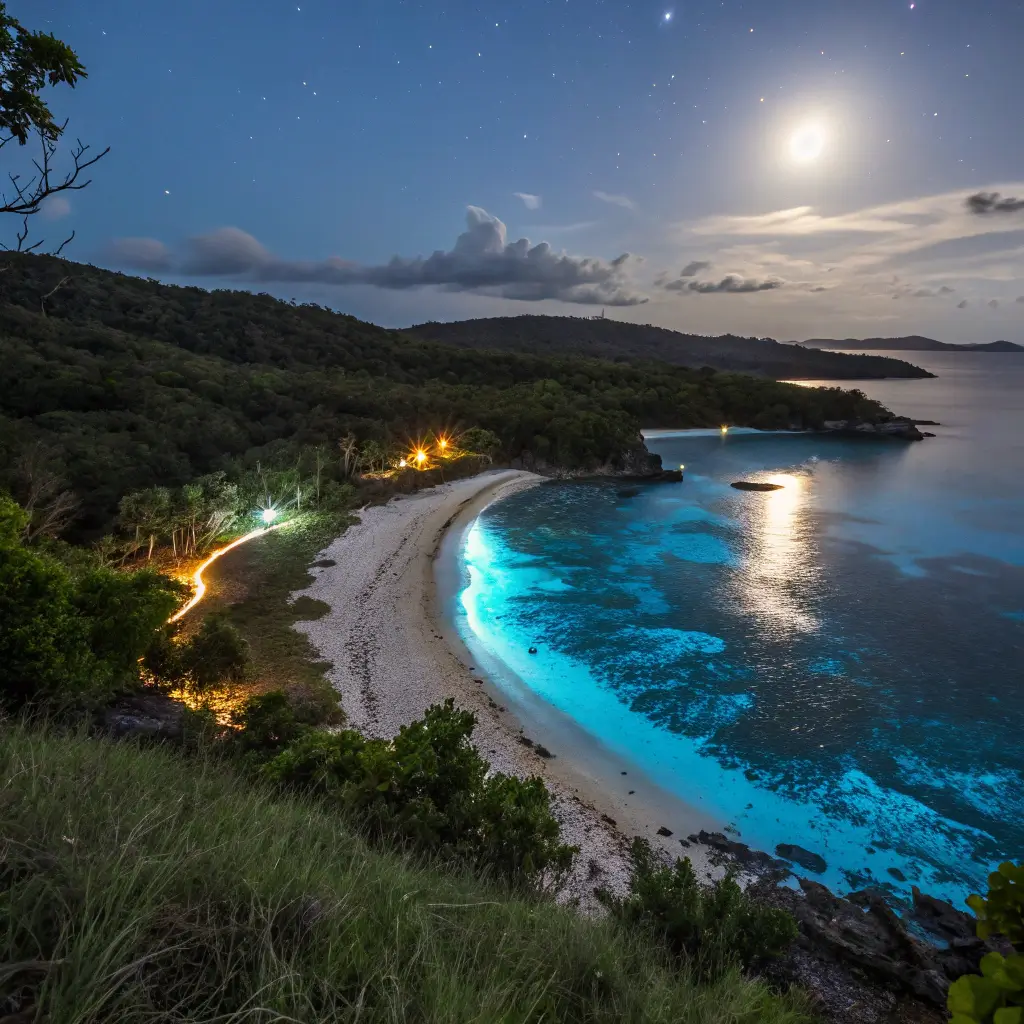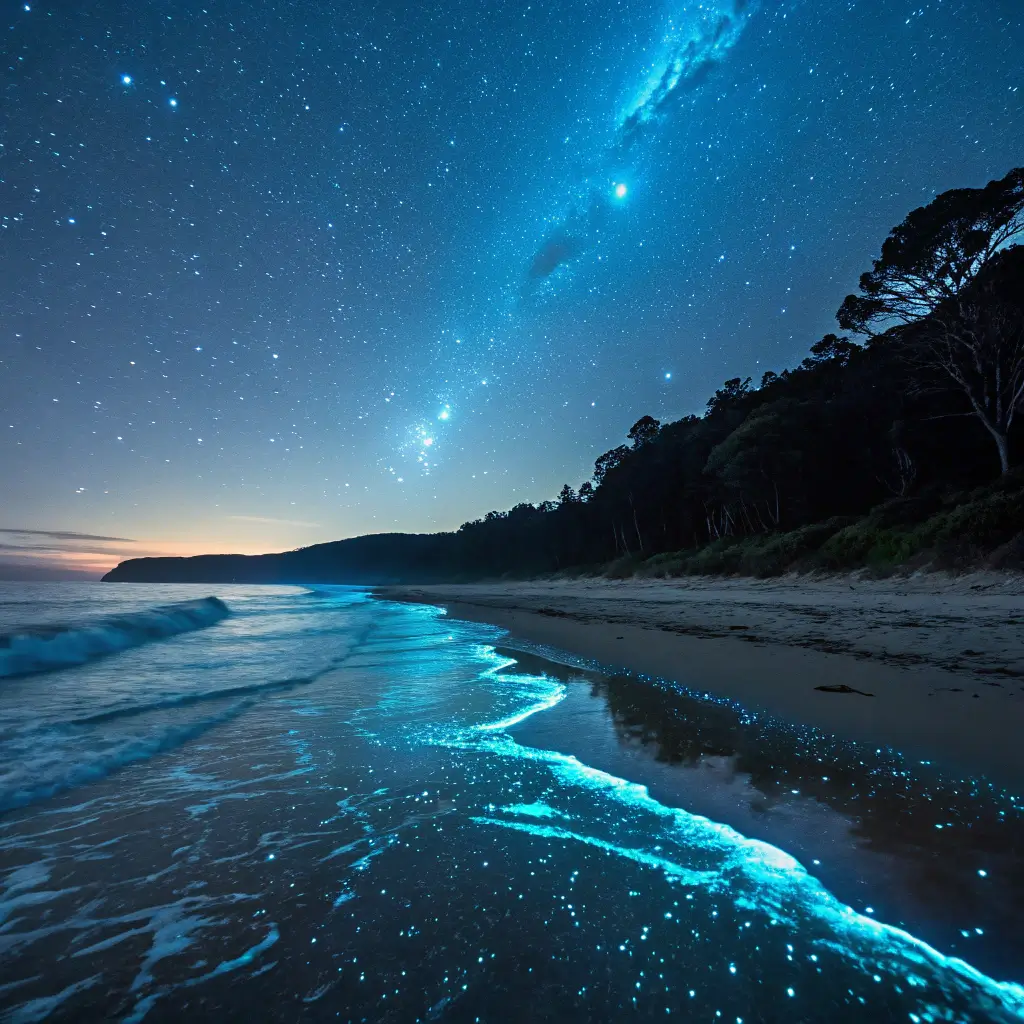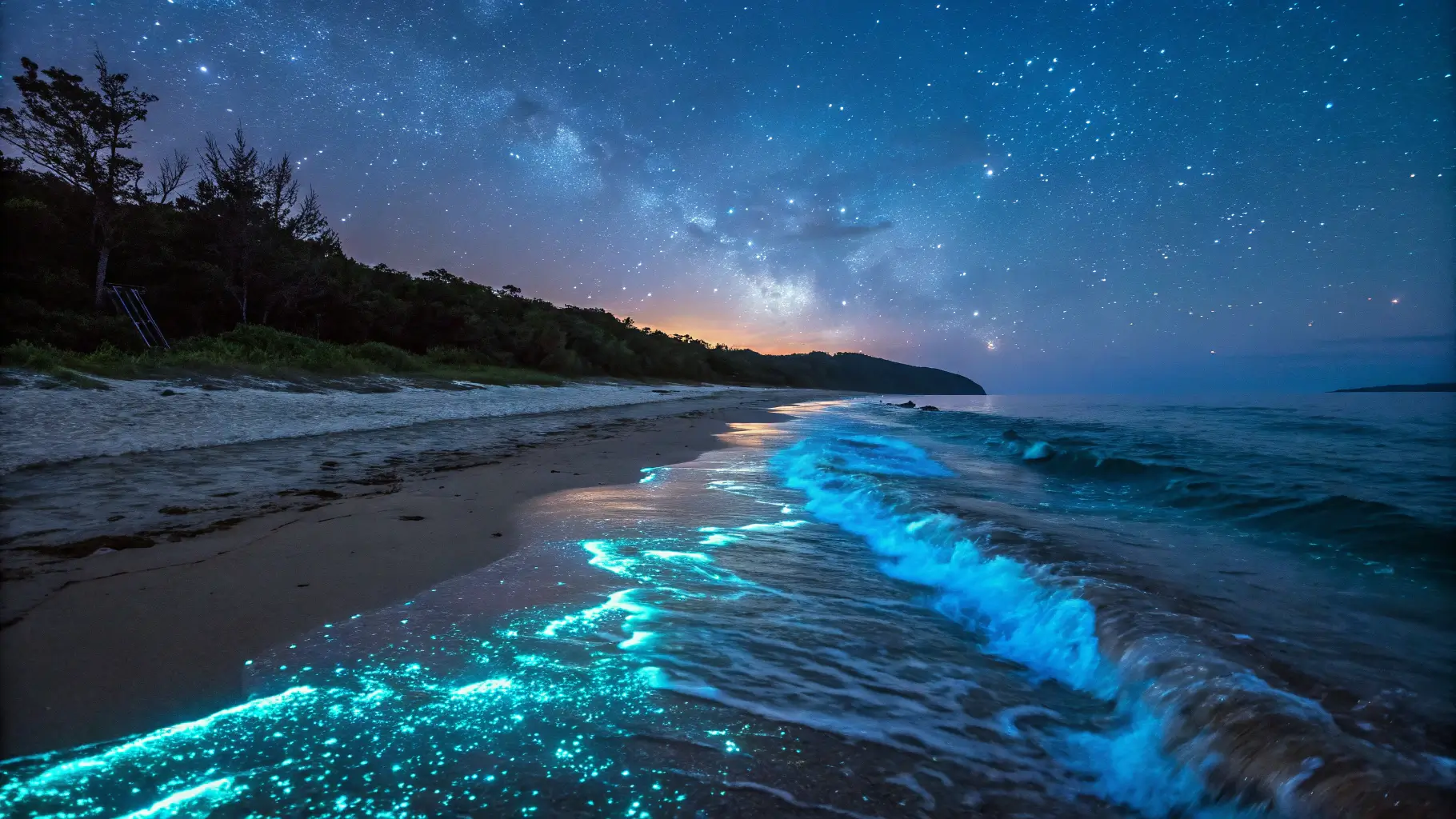Bioluminescent beaches are one of nature’s most enchanting phenomena, where the ocean glows with vibrant colors at night. This captivating display is caused by bioluminescence, a natural light phenomenon that occurs in various marine environments. These glowing beaches, often referred to as bioluminescent bays, attract eco-tourists and nature enthusiasts alike, eager to witness the magic of luminous waters. Understanding the science behind bioluminescence and the organisms responsible for this spectacle can enhance your appreciation of these stunning locations.
Table of Contents
What is Bioluminescence?

Bioluminescence is the production and emission of light by living organisms. This natural light phenomenon is primarily found in marine environments, although it can also occur in some terrestrial species. The light produced can serve various purposes, including attracting mates, deterring predators, and luring prey. Bioluminescent organisms utilize a chemical reaction involving luciferin and luciferase, resulting in the beautiful glow that illuminates bioluminescent beaches.
The Science Behind Bioluminescence
The science of bioluminescence is fascinating and complex. It involves a biochemical reaction that occurs in specialized cells or organelles. When luciferin, a light-emitting molecule, reacts with oxygen in the presence of the enzyme luciferase, light is produced. This reaction can occur in various conditions, leading to the stunning displays seen in glowing beaches. Factors such as water temperature, salinity, and nutrient availability can influence the intensity and frequency of bioluminescent events. Understanding these factors can help visitors time their trips to coincide with peak bioluminescent activity.
Organisms That Cause Bioluminescence
Several organisms contribute to the phenomenon of bioluminescence, with dinoflagellates being the most well-known. These single-celled marine plankton are responsible for the glowing waters seen in many bioluminescent bays. Other contributors include certain species of jellyfish, algae, and bacteria. Each organism has its unique mechanism for producing light, but they all share the common trait of creating a mesmerizing glow in the dark. Understanding these bioluminescent organisms can enhance your experience when visiting glowing beaches, as you learn to appreciate the diversity of life that contributes to this natural wonder.
Top Bioluminescent Beaches Around the World
Bioluminescent beaches are a mesmerizing natural phenomenon that captivates visitors with their glowing waters. These luminous beaches are often home to bioluminescent organisms, such as dinoflagellates, which create stunning displays of light at night. Here are some of the top bioluminescent beaches around the world that you should consider visiting.
Mosquito Bay, Vieques, Puerto Rico
Mosquito Bay is renowned for its vibrant bioluminescence, making it one of the brightest bioluminescent bays in the world. The bay is home to millions of dinoflagellates, which emit a blue-green glow when disturbed. Visitors can kayak through the bay at night, witnessing the magical glow as they paddle. The best time to visit is during the new moon when the darkness enhances the luminous effect. Eco-tourism is encouraged here, with local guides offering safe and informative tours.
Bioluminescent Bay, Fajardo, Puerto Rico
Fajardo’s Bioluminescent Bay is another stunning location to experience marine bioluminescence. This bay is famous for its high concentration of bioluminescent organisms, creating a breathtaking spectacle. Night-time nature tours are available, allowing visitors to explore the glowing waters while learning about the ecosystem. The bay’s unique conditions, including mangroves and shallow waters, contribute to its vibrant glow. Safety tips include wearing life jackets and following guides to ensure a safe experience.
Luminous Lagoon, Jamaica
The Luminous Lagoon in Jamaica is a must-visit for those seeking glowing beaches. This lagoon is known for its bioluminescent waters, which shimmer with a bright blue light. The phenomenon is caused by microorganisms that thrive in the warm waters. Visitors can take boat tours to experience the glow up close, often jumping into the water to see the luminous effect firsthand. The best time to visit is during the warmer months when the bioluminescence is at its peak.
San Diego, California
San Diego’s beaches occasionally experience bioluminescence, particularly during certain times of the year. The phenomenon is often linked to the presence of dinoflagellates in the water. Night-time strolls along the beach can reveal glowing waves, especially after storms. Local surf spots may also showcase this natural light phenomenon. Beach safety tips include staying aware of tides and avoiding swimming alone at night.
Muriwai Beach, New Zealand
Muriwai Beach is famous for its stunning landscapes and occasional bioluminescent displays. The beach’s unique ecosystem supports various bioluminescent organisms, creating a magical atmosphere at night. Visitors can explore the beach and witness the glowing sands and waters. The best time to see the bioluminescence is during warm, calm nights. Safety tips include staying on marked paths and being cautious of wildlife.

Best Times to Visit Bioluminescent Beaches
Experiencing a bioluminescent beach is a magical event that many travelers seek. Timing your visit can significantly enhance your experience. Understanding seasonal variations and weather conditions is crucial for witnessing this natural light phenomenon at its best.
Seasonal Variations
Bioluminescent beaches often have peak seasons when the glowing waters are most vibrant. In many locations, summer months are ideal due to warmer waters and increased dinoflagellate activity. For instance, Puerto Rico’s Mosquito Bay shines brightest from June to October. In contrast, some bioluminescent bays may be more active during winter months, particularly in warmer climates. Research specific locations to find out their peak seasons. Additionally, local events or eco-tourism initiatives may coincide with these peak times, offering guided tours for optimal viewing.
Weather Conditions
Weather plays a significant role in the visibility of bioluminescent organisms. Clear, calm nights are best for viewing luminous waters. Overcast skies or heavy winds can diminish the glow. Check local forecasts before planning your visit. Humidity can also affect visibility; higher humidity often leads to better bioluminescence. Avoid visiting during the full moon, as its brightness can overshadow the natural glow. Always consider beach safety tips, such as checking tide schedules and ensuring safe access to the beach at night.
How to Experience Bioluminescent Beaches Safely
Visiting a bioluminescent beach can be a magical experience, but safety should always come first. Here are some essential tips to ensure your nighttime adventure is both enjoyable and secure.
Safety Tips for Nighttime Visits
1. Wear appropriate footwear to protect your feet from sharp objects.
2. Bring a flashlight with a red filter to minimize light pollution and preserve the natural ambiance.
3. Stay on marked paths to avoid disturbing delicate ecosystems.
4. Keep a safe distance from the water’s edge, especially if tides are unpredictable.
5. Travel in groups for added safety and to enhance the experience.
6. Be aware of local wildlife and avoid disturbing any animals you encounter.
7. Check weather conditions before your visit to ensure a safe experience.
Environmental Considerations
1. Respect the natural habitat of bioluminescent organisms like dinoflagellates.
2. Avoid using chemical sunscreens or lotions that can harm marine life.
3. Follow eco-tourism guidelines to minimize your impact on the environment.
4. Do not collect sand, shells, or any marine organisms.
5. Dispose of waste properly to keep the beach clean and safe for wildlife.
6. Educate yourself about the local ecosystem and its importance in maintaining luminous waters.
7. Support conservation efforts to protect these natural light phenomena for future generations.
Photography Tips for Capturing Bioluminescence
Capturing the enchanting beauty of a bioluminescent beach can be a rewarding experience. With the right equipment and techniques, you can immortalize the glowing waters and the magic of night-time nature. Here are some essential tips to help you get stunning photographs of these luminous waters.
Equipment Recommendations
1. Camera: A DSLR or mirrorless camera is ideal for low-light conditions. Look for models with good high ISO performance.
2. Tripod: A sturdy tripod is essential for long exposure shots. It stabilizes your camera and prevents blurriness.
3. Lens: A wide-angle lens (f/2.8 or lower) allows more light to enter, capturing more of the bioluminescent glow.
4. Remote Shutter Release: This minimizes camera shake during long exposures, ensuring sharp images.
5. Extra Batteries: Night photography can drain batteries quickly, so bring spares to avoid missing the perfect shot.
Techniques for Night Photography
1. Use Long Exposures: Set your camera to a long exposure (10-30 seconds) to capture the glow of bioluminescent organisms effectively.
2. Adjust ISO Settings: Start with a higher ISO (800-3200) to capture more light, but be cautious of noise in your images.
3. Focus Manually: Autofocus may struggle in low light. Switch to manual focus and use a flashlight to assist in focusing on your subject.
4. Experiment with Composition: Include elements like the shoreline or silhouettes to create depth and interest in your photos.
5. Be Patient: Wait for the right moment, as bioluminescence can vary in intensity. Enjoy the experience while capturing the beauty around you.

Conclusion: The Magic of Bioluminescent Beaches
Bioluminescent beaches are a breathtaking natural phenomenon that captivates visitors with their glowing waters. These luminous displays are primarily caused by bioluminescent organisms, particularly dinoflagellates, which emit light when disturbed. The experience of walking along a glowing beach at night is truly magical, offering a unique connection to nature. As eco-tourism grows, more people are seeking out these glowing beaches, making it essential to prioritize their preservation. By following beach safety tips and respecting local ecosystems, we can ensure that future generations will also be able to enjoy the wonder of bioluminescent bays. Whether you’re planning a trip or simply dreaming of the ocean’s night-time nature, the allure of bioluminescent beaches is undeniable.
FAQs About Bioluminescent Beaches
1. What causes the glow in bioluminescent beaches?
The glow is primarily caused by microorganisms like dinoflagellates that emit light when disturbed.
2. Are bioluminescent beaches safe to visit?
Yes, they are generally safe, but it’s important to follow local guidelines and safety tips.
3. When is the best time to see bioluminescence?
The best time is usually during warm summer months and on dark, moonless nights.
4. Can I swim in bioluminescent waters?
Swimming is often allowed, but check local regulations and safety advisories.
5. How can I help protect bioluminescent ecosystems?
Avoid using harmful chemicals, follow local guidelines, and respect wildlife habitats.


